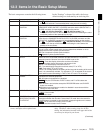
Chapter 11 Function Menu
Chapter 11 Function Menu 11-7
Item Setting
F1 (CAPSTN) Selects the number of fields for capstan lock in playback and editing.
For DVW-M2000/2000
2F: The capstan servo locks in units of 2 fields.
• For tape output, color framing may not match the reference signal selected with the F2 (OUTREF).
• In assemble editing, color framing may be non-continuous at edit points.
When playing back a tape that was recorded with composite source signals, a vertical shift in the video
(H shift) occurs. (When setup menu item 712 is set to ON.)
4F: The capstan servo locks in units of 4 fields.
• For tape output, color framing matches the reference signal selected with the F2 (OUTREF).
• In assemble editing, color framing is continuous at edit points.
Even when playing back a tape that was recorded with composite source signals, no vertical shift in
the video (H shift) occurs. You should set this menu item to this setting when you are editing
composite signals, when continuity in video phase across edit points is required, and when you
perform A/B-roll editing.
For DVW-M2000P/2000P
2F: The capstan servo locks in units of 2 fields.
• For tape output, color framing may not match the reference signal selected with the F2 (OUTREF).
• In assemble editing, color framing may be non-continuous at edit points.
When playing back a tape that was recorded with composite source signals, a vertical shift in the
video (H shift) occurs. (When setup menu item 712 is set to ON.)
4F: The capstan servo locks in units of 4 fields.
• For tape output, color framing may not match the reference signal selected with the F2 (OUTREF).
• In assemble editing, color framing may be non-continuous at edit points.
When playing back a tape that was recorded with composite source signals, a vertical shift in the
video (H shift) occurs. (When setup menu item 712 is set to ON.)
8F: The capstan servo locks in units of 8 fields.
• For tape output, color framing matches the reference signal selected with the F2 (OUTREF).
• In assemble editing, color framing is continuous at edit points.
Even when playing back a tape that was recorded with composite source signals, no vertical shift in
the video (H shift) occurs. You should set this menu item to this setting when you are editing
composite signals, when continuity in video phase across edit points is required, and when you
perform A/B-roll editing.
F2 (OUTREF) Selects the reference signal of this unit, according to the setting of setup menu item 309 and this unit’s
operating state.
REF: Use the signal input to the REF.VIDEO INPUT connector as the reference signal. During recording,
input digital audio signals and video signals must be synchronized with this signal.
INPUT: Use the input video signal selected in the F1 (VID.IN) of the HOME page as the reference signal.
F3 (DOLBY)
(DVW-M2000/
M2000P only)
When using oxide tapes, specifies whether or not to use the Dolby type C low-frequency noise reduction
(NR) system.
NR ON: Use the Dolby NR system when playing back analog Betacam oxide tapes.
NR OFF: Do not use the Dolby NR system when playing back analog Betacam oxide tapes.
F4 (CHARA) Specifies whether or not to superimpose time code, menu settings, error messages, and so on over the
video signals output to the 3 (SUPER) connector in the SDI OUTPUT connectors, and the 3 (SUPER)
connector in the COMPOSITE VIDEO OUTPUT connectors.
ON: Superimpose.
OFF: Do not superimpose.
(Continued)
Page 4


















